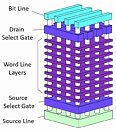Monday, November 16th 2020
NEO Semiconductor X-NAND Standard Offers Performance Comparable to SLC at Costs of QLC, Wins FMS 2020 Best of Show
NEO Semiconductor was honored with a Flash Memory Summit 2020 Best of Show Award for Hardware Architecture at today's Flash Memory Summit 2020 Best of Show Awards ceremony. The Flash Memory Summit, the World's largest and most prestigious storage industry conference and exposition, recognizes NEO Semiconductor's X-NAND product solution.
"5G, robotics, virtual reality and AI applications demand the highest level of performance in order to meet the service level objectives of business-critical data center workloads," said Jay Kramer, Chairman of the Awards Program and President of Network Storage Advisors Inc. "We are proud to recognize NEO Semiconductor X-NAND product solution for providing an excellent high-performance solution that can uniquely lower the cost across all tiers of SSD technologies.""We are delighted to receive this award in the world-famous Flash Memory Summit. It is a fantastic honor and achievement for the debut of X-NAND," said Andy Hsu, founder and CEO, NEO Semiconductor. "X-NAND architecture is a monumental breakthrough in NAND flash memory design. From SLC to QLC, each generation's NAND flash capacity has grown larger and costs have become cheaper, but its speed has also become significantly slower. This bottleneck for QLC NAND prevents its use in applications that require high speed performance. Our X-NAND architecture solves this bottleneck by increasing the planes of the array using the existing page buffer size, which increases the parallelism for read and write operations. As a result, X-NAND can achieve QLC density with SLC speed."
According to show organizers, a record number of award submissions were received this year making the judging challenging and each of the categories extremely competitive.
Details of the FMS 2020 award can be found here.
"5G, robotics, virtual reality and AI applications demand the highest level of performance in order to meet the service level objectives of business-critical data center workloads," said Jay Kramer, Chairman of the Awards Program and President of Network Storage Advisors Inc. "We are proud to recognize NEO Semiconductor X-NAND product solution for providing an excellent high-performance solution that can uniquely lower the cost across all tiers of SSD technologies.""We are delighted to receive this award in the world-famous Flash Memory Summit. It is a fantastic honor and achievement for the debut of X-NAND," said Andy Hsu, founder and CEO, NEO Semiconductor. "X-NAND architecture is a monumental breakthrough in NAND flash memory design. From SLC to QLC, each generation's NAND flash capacity has grown larger and costs have become cheaper, but its speed has also become significantly slower. This bottleneck for QLC NAND prevents its use in applications that require high speed performance. Our X-NAND architecture solves this bottleneck by increasing the planes of the array using the existing page buffer size, which increases the parallelism for read and write operations. As a result, X-NAND can achieve QLC density with SLC speed."
According to show organizers, a record number of award submissions were received this year making the judging challenging and each of the categories extremely competitive.
Details of the FMS 2020 award can be found here.

15 Comments on NEO Semiconductor X-NAND Standard Offers Performance Comparable to SLC at Costs of QLC, Wins FMS 2020 Best of Show
My questions are: is this any more reliable than QLC NAND? Will manufacturers forgo QLC and TLC altogether if this proves to be comparable in reliability to TLC? How will this affect product stacks?
Even if the answers are disappointing, I still like to see new flash developments.
neosemic.com/white-paper
"Bank 1 performs SLC programming for input data, Bank 2 performs QLC programming to move data from SLC pages to QLC pages, and Bank 3 (will) erase the old data in SLC pages" - at 8 planes per bank, there's 32 pages of data at 4 SLC pages each plane programmed to Bank 1, Bank 2 reads these to 8 planes of QLC pages. So it's always first programmed and erased in a static SLC-like manner (which has higher endurance than native flash and dynamic SLC, usually 30K P/E) with bitline shielding which would be closer to 1.6K P/E in QLC. He actually doesn't explicitly state endurance - I need to ask him about that - but it would be dependent on workload. My guess would be a goal of TLC-like endurance.
i dont care if stuff is "enterprise/data center" or whatever, as long as i can use it (interface) and buy it,
but anything below MLC (maybe TLC for nvme) is a no for me when it comes to OS/game/backup drives.
It is possible that this new type of NAND is more durable than QLC(the design leans in that direction), but will it be better than TLC and closer to SLC?But how well? TLC levels? MLC levels? Maybe somewhere inbetween SLC and MLC?
I know, ASCII art is cool, but not everyone has mastered that.
Man my youth sucked